- How many astronauts have died exploring space? Have any Russians ever been killed in space?
- question from Marie Ortega
Posted by aerospaceweb.org
Valentin V. Bondarenko (Soviet Air Force), training accident
Bondarenko was an Air Force pilot selected for cosmonaut training in 1960. He was killed on 23 March 1961 while training in a ground-based spacecraft simulator. Fire broke out in the capsule, which was filled with a pure oxygen atmosphere, and he was unable to escape.
Theodore C. Freeman (USAF), aircraft accident
Capt. Freeman had been an instructor training test pilots at the USAF Aerospace Research Pilot School at Edwards Air Force Base. He had over 3,000 hours of flight time and was selected for the astronaut program in October 1963. He was to be trained to pilot an Apollo mission. Freeman died on 31 October 1964 during a routine flight aboard one of NASA's T-38 jet trainers. He was preparing to land near Houston when a snow goose struck the left side of the cockpit canopy. Shattered plexiglass entered both engines forcing Freeman to eject. However, his altitude was too low and the parachute had insufficient time to fully open. Freeman was buried at Arlington National Cemetery.
Charles A. Bassett II (USAF)
Elliot M. See, Jr., aircraft accident
Capt. Bassett completed test pilot training at the Air Force Experimental Pilot School and the Aerospace Research Pilot School and had logged over 3,600 hours flight time. He was selected for the space program in October 1963.
Elliot See had been a US Navy pilot as well as a flight test engineer and experimental test pilot with General Electric. His work on jet engine development had earned him 3,900 flight hours in such aircraft as the F-86, XF4D, F-104, F11F-1F, RB-66, F4H, and T-38. In September 1962, See was selected for astronaut training.
Both were scheduled to be the primary crew aboard Gemini 9, See as commander and Bassett as pilot. They were on their way to McDonnell Aircraft Corporation's Lambert Field near St. Louis to discuss their mission with McDonnell engineers on 28 February 1966. However, overcast skies mixed with rain and snow flurries resulted in poor visibility. Their T-38 came in too low and slow on the first landing attempt, so pilot See went to afterburner and turned right to make another attempt. Unfortunately, his turn took the aircraft right into the roof of McDonnell Building 101, killing both men. Coincidentally, this very building contained the Gemini 9 spacecraft the two men were due to fly.
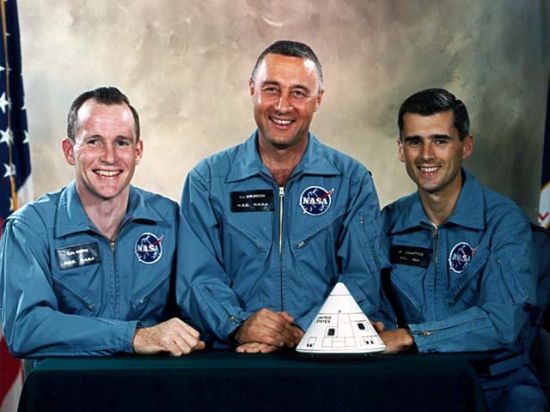
Apollo 1 crew
Virgil I. "Gus" Grissom (USAF)
Edward H. White II (USAF)
Roger B. Chaffee (USN), Apollo 1
Gus Grissom had flown combat missions over Korea, served as a jet instructor, and completed Test Pilot School before becoming a test pilot at the Wright-Patterson Air Force Base fighter branch. He had logged 4,600 flight hours and was selected as one of the original seven Mercury astronauts on 9 April 1959. His first mission into space was Mercury 4 on 21 July 1961 wherein he piloted the Liberty Bell 7 capsule. After completing a 15 minute, 37 second suborbital flight, the capsule landed at sea and sank after the hatch blew open accidentally, but Grissom escaped safely. Lt. Col. Grissom later commanded Gemini 3, completing 3 orbits on 23 March 1965.
Lt. Col. White attended West Point, completed flight training, and served as a fighter pilot in West Germany, flying the F-86 and F-100. He later attended USAF Test Pilot School and was assigned to Wright-Patterson AFB as an experimental test pilot with the Aeronautical Systems Division. He logged over 4,236 flight hours and was selected for astronaut training in September 1962. His first mission was pilot of Gemini 4, which lasted from 3-7 June 1965 and completed 62 orbits. During this mission, White became the first American to perform a spacewalk.
LT CDR Chaffee was a naval officer specializing in photographic reconnaissance. Chaffee went on to fly U-2 photo reconnaissance flights over Cuba and helped document the Soviet buildup that precipitated the Cuban Missile Crisis. He logged more than 2,300 flight hours and entered the astronaut program in October 1963. He was to be pilot on Apollo 1, his first space flight.
All three were assigned as the primary crew of Apollo 1. The mission was planned to launch on 21 February 1967 and complete 14 days in Earth orbit. On 27 January, the three were sealed in the Apollo 1 capsule on the launch pad to perform pre-flight tests. A spark caused by faulty wiring erupted into a blaze that swept through the pure oxygen atmosphere within the capsule. Unable to open the escape hatch, all three were killed. Grissom and Chaffee were buried at Arlington National Cemetery and White at West Point.
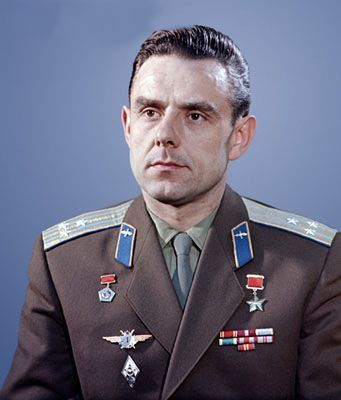
Vladimir Komarov
Vladimir M. Komarov (Soviet Air Force), Soyuz 1
Col. Komarov was an Air Force pilot selected for cosmonaut training in 1960. He was trained for both Vostok and Voshkod missions before making his first trip into space as commander of Voshkod 1 on 12 October 1964. Komarov was later selected to pilot Soyuz 1, which was launched on 23 April 1967. Initial plans called for Soyuz 2, with a crew of three, to launch shortly thereafter and rendezvous with Komarov. Two engineers from Soyuz 2 were to transfer to Soyuz 1 and return back to Earth. However, problems emerged with Soyuz 1 almost immediately and the second craft was never launched. After completing 17 orbits during a 26 hour 40 minute flight, Soyuz 1 re-entered the atmosphere on 24 April and all appeared normal. However, the parachute lines became tangled at about 23,000 ft (7,015 m) causing the parachute to twist and deflate. The capsule hit the ground at 200 mph (320 km/h) and burst into flames, killing Komarov instantly.
Clifton C. Williams, Jr. (USMC), aircraft accident
Maj. Williams first graduated from the Navy Test Pilot School and became a test pilot in the Carrier Suitability Branch of the Flight Test Division at Patuxent River. He flew both land-based and shipboard tests of the F8E, TF8A, A4E, and automatic carrier landing systems, completing 2,600 hours of flying time. In October 1963, Williams was selected to become an astronaut. Though he had been named backup pilot for Gemini 10 as well as backup lunar module pilot for Apollo 3 and Apollo 9, Williams never completed a space flight. He was killed on 5 October 1967 when his NASA T-38 jet trainer crashed.
Michael J. Adams (USAF), aircraft accident
Maj. Adams flew 49 combat missions over Korea, attended USAF Aerospace Research Pilot School, and tested a lunar lander trainer. Though selected to become an astronaut in 1965 to serve aboard the Manned Orbiting Laboratory, Adams left the astronaut corp to become an X-15 pilot. He successfully completed six missions in the X-15 before his final flight on 15 November 1967. He had achieved a maximum speed of 3,561 mph (5,730 km/h) and a maximum altitude of 266,000 feet (81,150 m), but problems emerged as Adams descended to land. The vehicle entered a spin at a speed of Mach 5 followed by a sharp dive and high frequency pitch oscillations when at an altitude of about 18,600 ft (5,675 m). As the forces on the X-15 approached 15 g, the aircraft disintegrated killing Adams.
Robert H. Lawrence (USAF), aircraft accident
Maj. Lawrence completed flight training and later became a flight instructor for both the US and German Air Forces. He logged 2,500 flight hours and was selected as an astronaut for the Air Force Manned Orbiting Laboratory program in 1967. On 8 December of that year, Lawrence was co-pilot during a training mission aboard an F-104 that crashed at Edwards AFB. These F-104 flights were collecting data that later contributed to development of the Space Shuttle.
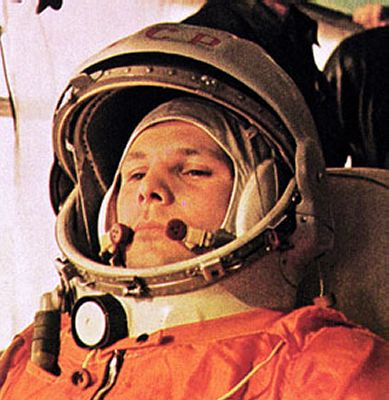
Yuri Gagarin
Yuri A. Gagarin (Soviet Air Force), aircraft accident
Yuri Gagarin became a cosmonaut in 1960 and the first human in space on 12 April 1961. His one orbit mission, Vostok 1, lasted 1 hour, 48 minutes. After his historic mission, Gagarin became a national hero and was deemed too imporant to risk sending on another space flight for several years. Instead, he supervised cosmonaut training, including that of Valentina Tereshkova, the first woman in space. He later became deputy director of the cosmonaut training center (now called the Yuri Gagarin Cosmonaut Training Center). Gagarin was returned to flight status in 1967 and would have commanded Soyuz 3 if not for the earlier tragedy aboard Soyuz 1. Before Soyuz began flying again, Col. Gagarin was killed on 27 March 1968 while conducting a proficiency flight in a MiG-15 trainer.
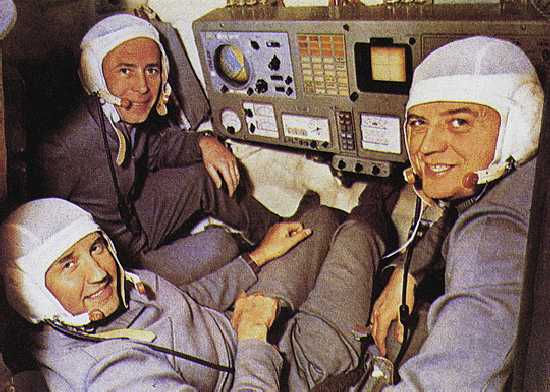
Soyuz 11 crew
Georgi T. Dobrovolsky (Soviet Air Force)
Viktor I. Patsayev
Vladislav N. Volkov, Soyuz 11
Oleg G. Kononenko, aircraft accident
Kononenko was a civilian test pilot selected for cosmonaut training in June 1980. He was to become a pilot for the Buran space shuttle, but died on 8 September 1980 in the crash of a Yak-38.
Leonid Ivanov (Soviet Air Force), aircraft accident
Ivanov was an Air Force pilot selected for cosmonaut training in December 1978. He was killed on 24 October 1980 during a MiG-27 test flight.
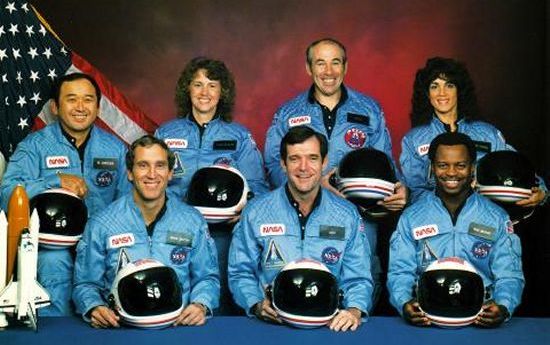
Challenger STS-51L crew
Lt. Col. Dick Scobee enlisted in the USAF in 1957, completed flight training, served a combat tour in Vietnam, and attended USAF Aerospace Research Pilot School. His flight testing career included the Boeing 747, X-24B, F-111, and C-5, and he logged more than 6,500 flight hours in 45 types of aircraft. Scobee became an astronaut candidate in January 1978. He completed pilot training for the Space Shuttle and was also an instructor pilot on the Boeing 747 Shuttle Carrier Aircraft. Scobee's first space flight was as pilot aboard Challenger STS-41C, logging 168 hours from 6-13 April 1984. He later commanded Challenger STS-51L.
CAPT Smith was a naval aviator and later an instructor at the Advanced Jet Training Command. He also flew the A-6 and completed a combat tour in Vietnam while stationed aboard USS Kitty Hawk. He completed training at the US Navy Test Pilot School and was assigned to the Strike Aircraft Test Directorate at Patuxent River. He was involved in testing the A-6E and also served as a flight instructor, logging 4,867.7 flight hours in 28 different types of civilian and military aircraft. Smith became an astronaut candidate in May 1980 and was qualified to pilot the Shuttle, which he did on STS-51L.
Lt. Col. Onizuka entered the USAF and became a flight test engineer at McClellan AFB. There he participated in flight test programs for the F-84, F-100, F-105, F-111, EC-121T, T-33, T-39, T-28, and A-1. He later attended USAF Test Pilot School and was assigned to the Air Force Flight Test Center at Edwards AFB. He logged more than 1,700 flight hours and entered astronaut training in January 1978. Onizuka's first flight into space was as a mission specialist on Discovery STS-51C. He completed 48 orbits from 24-27 January 1985 and logged 74 hours in space. Onizuka was also a mission specialist aboard Challenger STS-51L.
Dr. Judy "J.R." Resnik started her career as an engineer specializing in circuit design and integrated circuitry. She later became a biomedical engineer at the National Institutes of Health where she conducted research into the physiology of visual systems. Immediately before becoming an astronaut, she was a senior systems engineer with Xerox. Resnick was selected for the astronaut program in January 1978, and she was a mission specialist on Discovery STS-41D from 30 August to 5 September 1984. One experiment aboard that flight was shooting footage used in the IMAX film The Dream is Alive. Resnick completed 96 orbits and logged 144 hours, 57 minutes in space. She was also a mission specialist on STS-51L.
Dr. Ron McNair was a specialist in lasers at Hughes Research Laboratories. Some of his areas of research included the development of lasers for isotope separation and photochemistry, satellite-to-satellite communications, and ultraviolet atmospheric remote sensing. In 1978, he became an astronaut candidate and was qualified as a mission specialist on the Shuttle. His first flight occurred from 3-11 February 1984 on Challenger STS-41B. During this mission, McNair was the first to use the robotic arm to position a crewman during an EVA. McNair logged 191 hours in space. He was also a mission specialist on STS-51L.
Gregory Jarvis had been a USAF officer assigned to the space division in El Segundo. He was later employed by Hughes as a communications engineer and was promoted to assistant spacecraft system engineering manager. Jarvis was a mission specialist aboard Challenger STS-51L responsible for conducting fluid dynamics experiments to determine the reactions of satellite propellants to various shuttle maneuvers and simulated movements.
Christa McAuliffe was a teacher of 7th and 8th grade history and English as well as high school economics, law, history and social studies in Concord, New Hampshire. She was selected by NASA to be the first teacher in space. Aboard Challenger STS-51L, McAuliffe was to teach lessons to school children via satellite including "The Ultimate Field Trip" and "Where We've Been, Where We're Going and Why."
The crew of Challenger were killed on 28 January 1986 when the vehicle disintegrated 76 seconds after liftoff following the failure of the aft field joint on the right Solid Rocket Booster (learn more).
CAPT Manley L. "Sonny" Carter, Jr. (USN), aircraft accident
CAPT Carter was a US Navy flight surgeon before becoming a naval aviator in 1978. He became senior medical officer aboard USS Forrestal and later an F-4 pilot. Carter completed Top Gun training at the USN Fighter Weapons School and also attended USN Test Pilot School. He had logged 2,400 flight hours and 160 carrier landings. Carter enetered astronaut training in May 1984 and was trained to perform EVA duties on Discovery STS-33. During this mission, Carter completed 79 orbits and logged 120 space hours from 22-27 November 1989. He was also selected as a mission specialist for Discovery STS-42. While traveling on NASA business, Carter was aboard an Atlantic Southeast Airlines plane that crashed on 5 April 1991, killing all aboard.
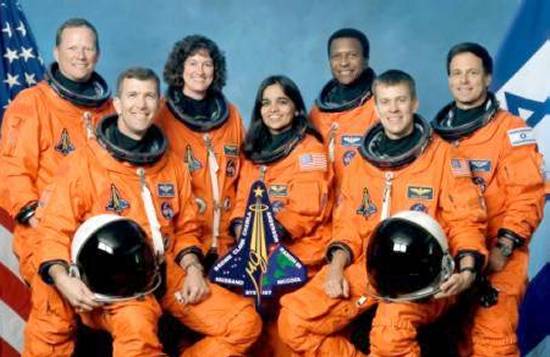
Columbia STS-107 crew
Col. Husband was a pilot who attended USAF Test Pilot School and was qualified to fly the F-4 and F-15. In June 1992, he became an exchange test pilot with the Royal Air Force and performed test flights in the Tornado GR1 and GR4, Hawk, Hunter, Buccaneer, Jet Provost, Tucano, and Harvard. He logged over 3,800 flight hours in more than 40 different types of aircraft. Husband was selected as an astronaut candidate in December 1994. His first mission was pilot on Discovery STS-96 before becoming commander on Columbia STS-107. He logged 24 days, 51 hours, 33 minutes in space.
CDR McCool was a USN aviator who participated in the Naval Postgraduate School/Test Pilot School Cooperative Education Program. Afterwards, he became a TA-4J and EA-6B test pilot at the Strike Aircraft Test Directorate at Patuxent River. Before joining NASA, McCool served in an EA-6B squadron aboard USS Enterprise. McCool logged over 2,800 flight hours in 24 aircraft and had over 400 carrier landings. He was selected for the space program in April 1996 and qualified as a Shuttle pilot. His first mission was pilot on STS-107, and he logged 15 days, 22 hours, 20 minutes in space.
Lt. Col. Anderson was a USAF communications officer and later trained to pilot an EC-135 airborne command post. He also served as an aircraft commander and instructor pilot in airborne refueling squadrons. Anderson logged over 3,000 hours in various models of the KC-135 and T-38. He became an astronaut candidate in December 1994 and was qualified as a mission specialist. His first space flight was aboard Endeavour STS-89 from 22-31 January 1998 during which Anderson logged over 211 hours in space. Anderson was also assigned to the crew of STS-107 as payload commander.
CAPT Brown was a US Navy flight surgeon who later entered pilot training and became a naval aviator qualified in the A-6E and F-18. He also served at the Naval Strike Warfare Center in Fallon, Nevada, and the US Naval Test Pilot School. Brown logged over 2,700 flight hours and was selected for astronaut training in April 1996. He completed mission specialist training and was qualified to support payload development for the International Space Station. Brown's first space flight was aboard Columbia STS-107 during which he logged 15 days, 22 hours, and 20 minutes in space.
Dr. Chawla was a researcher at NASA Ames Research Center studying the computational fluid dynamics of powered-lift and complex air flows around aircraft in ground-effect. She later moved to Overset Methods Inc. as Vice President and Research Scientist where she developed techniques to perform aerodynamic optimization. Chawla became an astronaut candidate in December 1994. Her first space flight was aboard Columbia STS-87 from 19 November to 5 December 1997 as mission specialist and robotic arm operator. STS-87 completed 252 orbits. Chawla was also a mission specialist aboard STS-107. She logged a total of 30 days, 14 hours, 54 minutes in space.
CDR Clark was a US Navy diver and surgeon. Her duties included operations with Navy divers and Navy SEALs as well as performing medical evacuations from submarines. She also completed aeromedical training and served as flight surgeon for several Marine and Navy units. Her military qualifications included Radiation Health Officer, Undersea Medical Officer, Diving Medical Officer, Submarine Medical Officer, and Naval Flight Surgeon. Clark was selected for astronaut training in April 1996 and was qualified a mission specialist. Her first flight was aboard Columbia STS-107 during which she logged 15 days, 22 hours, and 20 minutes in space.
Col. Ramon was a fighter pilot with the Israel Air Force (IAF) and held a number of important positions within the IAF. Before beginning astronaut training, Ramon was Head of the Department of Operational Requirement for Weapon Development and Acquisition. He accumulated over 3,000 flight hours on the A-4, Mirage III-C, and F-4, plus another 1,000 hours on the F-16. In 1997, Ramon was selected as a Payload Specialist and was trained to operate a multispectral camera. His training lasted until 2003 when he flew aboard Columbia STS-107. Ramon logged 15 days, 22 hours, 20 minutes in space.
The crew of Columbia successfully completed their 16-day mission in space but perished during re-entry on 1 February 2003. The investigation into why Columbia broke up 16 minutes before landing is still on-going, but a more thorough explanation of the disaster will be available in a future question.
Additional information on NASA astronauts is available at the NASA Astronaut Office.
- answer by Greg Alexander, 9 March 2003
Article link: http://www.aerospaceweb.org/question/history/q0114.shtml
THANK YOU ASTRONAUTS, for doing all that you ALL have done for us. God bless you and your family and friends. And the ones that have lost their life, may you rest in peace...
ReplyDelete